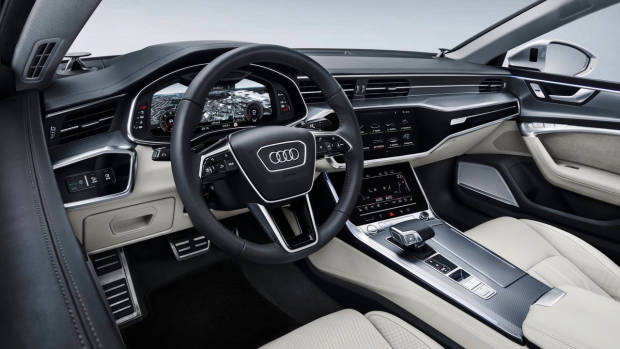-
Car Reviews
- All reviews
- Midsize SUVs
- Small cars
- Utes
- Small SUVs
- Large SUVs
- Large cars
- Sports SUVs
- Sports cars
- Vans
Latest reviews
- Car News
-
Car Comparisons
Latest comparisons
- Chasing Deals
The second generation Audi’s large-sized four-door ‘coupe’ offering, the A7 Sportback, has been revealed at an event overnight in Ingolstadt, Germany. The new A7 Sportback promises to be more technology-filled, more efficient and more dynamic than the outgoing model.
Ushering in the second iteration of Audi’s new design language after the all-new A8 luxury limo, the new A7 continues to offer the current model’s more emotional and svelte styling, with a new mix of aggression and modernity. The new A7 Sportback will be launched in Australia half way though 2018, and will compete with cars such as the BMW 6 Series Gran Coupe and Mercedes-Benz CLS, both of which are due to be replaced in the near future.

Drawing inspiration from the 2015 Audi Prologue concept car, and the new generation of A8, the new A7 Sportback is a more stylish car than it replaces. Aggressive-looking headlights sit beside Audi’s bold new singleframe grille, with available technology including laser LED lighting. Audi says the grille’s wide stance emphasises the car’s sportiness, and makes it appear lower and wider. The old generation A7’s front and rear shoulder lines have made it onto the new model, a move that was to make the car appear muscular and sporty. According to Marc Lichte, head of design at Audi, “The four-door Gran Turismo with its sculptural design embodies Audi’s progressiveness and dynamism.”

According to Audi, the rear of the 2018 A7 Sportback is ‘tapered like a yacht’, with very different tailights than the last model. Instead of a winching look that the old A7 Sportback was known for, the new model features a more aggressive look, completed by an LED strip that joins both lights. Particularly interesting is the start up procedure, which sees various elements of the rear lighting activate when the car is unlocked. The new model keeps the old A7’s rear spoiler, which is integrated into the bootlid and rises automatically at 120km/h.
Dimensionally, the new generation A7 sits at 4,969mm long with a 2,926mm wheelbase, but 1,908mm wide and 1,422mm high – 5mm shorter, 3mm less wide and 2mm higher than the old model. Crucially, the new A7’s wheelbase is 12mm longer than the old A7, which Audi claims makes new car roomier car than before, particularly for rear passenger’s head- and leg-room. Despite the different dimensions, the new A7’s bootspace is still rated at 535-litres with the rear seats up, and 1,390-litres with them folded.

The interior of the 2017 A7 Sportback continues the theme set by the new generation of A8. Instead of the former MMI integrated rotary dial, Audi appears to be now using touchscreens as the main form of interaction with the car’s infotainment system. The standard unit is a large 10.1-inch screen, with smartphone mirroring technology and housing other systems such as 360-degree parking camera. Below the main infotainment screen is a second touchscreen like the one found in the Range Rover Velar, which controls functions such as the climate control and heated/cooled seats. These two screens are coupled with a 12.3-inch version of Audi’s Virtual Cockpit digital dials system.
The layout of the new A7’s interior is also quite different to the model it replaces, with sleek air vents sitting atop the dashboard, and a central vent line extending across the dashboard. Below this sits the infotainment screen, which appears to sit in the dashboard. On the passenger side, the dashboard protrudes in the passenger space, which really emphasises the driver focus of the interior’s design. There’s also lots of satin chrome around the cabin, to emphasise the A7’s luxurious feel, according to Audi.

Audi claims that the new A7 is one of their most dynamic cars yet, a claim that is boosted by the addition of rear-wheel steering to the range. Particularly useful at lower speeds such as when parking, the rear-wheel steering system will steer counter to the front wheels to increase the agility of the car as much as 5 degrees. Audi claims that this reduces the turning circle at full lock by a full 1.1 metres, and at speeds of 60km/h or above, the rear axle steers in the same direction to increase straight-line stability and help lane changing.
Not much of the new A7’s engine lineup has been revealed as yet, aside from the 250kW/500Nm 3.0-litre turbocharged V6 petrol engine dubbed 55TFSI under Audi’s new naming structure that will be sold in most markets. This engine gives performance of 5.3 seconds to 100km/h, with an electronically limited top speed of 250km/h. It’s matched to a seven-speed dual-clutch automatic and Audi’s quattro all-wheel drive system as standard, whilst Audi claims combined fuel consumption of just 6.8L/100km and CO2 emissions of 154g/km.

Other four- and six-cylinder units, both petrol and diesel, are due to be revealed before the new A7’s on sale date next year. Most interestingly is that like the new A8, all drivetrain options will be fitted with a 48V electrical system and a MHEV – mild-hybrid electric vehicle – drivetrain. This means that a belt alternator works with a lithium ion battery to store wasted energy whilst the car is braking, and therefore using less fuel. The car’s stop-start system also works at up to 22km/h whilst coasting to red traffic lights.
Audi Australia have confirmed that the new A7 Sportback will be making its way Down Under half way through 2018, with local specifications and pricing due to be announced before then.

Stay tuned to Chasing Cars for news regarding the Audi A7 Sportback.
Latest news
About Chasing cars
Chasing Cars reviews are 100% independent.
Because we are powered by Budget Direct Insurance, we don’t receive advertising or sales revenue from car manufacturers.
We’re truly independent – giving you Australia’s best car reviews.